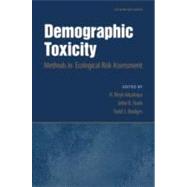
Note: Supplemental materials are not guaranteed with Rental or Used book purchases.
Purchase Benefits
Looking to rent a book? Rent Demographic Toxicity Methods in Ecological Risk Assessment (with CD-ROM) [ISBN: 9780195332964] for the semester, quarter, and short term or search our site for other textbooks by Akcakaya, H. Resit; Stark, John D.; Bridges, Todd S.. Renting a textbook can save you up to 90% from the cost of buying.
| Contributing Authors | p. vii |
| Demographic Toxicity: Assessing the Population-Level Impacts of Contaminants | p. 3 |
| Lucilia sericata Laboratory Populations: Toxicant Effects Modified by Stage-Specific Density Dependence and Stochasticity | p. 20 |
| Population-Level Modeling of Mercury Stress in the Florida Panther (Puma concolor coryi) Metapopulation | p. 40 |
| Raccoon (Procyon lotor) Harvesting on and near the U.S. Department of Energy's Savannah River Site: Utility of Metapopulation Modeling for Prediction and Management of Hunter Risk | p. 54 |
| Earthworms (Lumbricus rubellus) in Northwestern Europe: Sublethal Effects of Copper on Population Viability | p. 68 |
| Stressor Impacts on Common Loons in New Hampshire, USA: A Demonstration Study for Effects of Stressors Distributed across Space | p. 80 |
| Population-Level Effects of PCBs on Wood Frogs (Rana sylvatica) Breeding in Vernal Pools Associated with the Housatonic River, Pittsfield to Lenoxdale, Massachusetts | p. 97 |
| Potential Effects of Freshwater and Estuarine Contaminant Exposure on Lower Columbia River Chinook Salmon (Oncorhynchus tshawytscha) Populations | p. 123 |
| Water Flea Daphnia pulex: Population Recovery after Pesticide Exposure | p. 143 |
| Lymnaea stagnalis: The Effects of Experimental Demographic Reduction on Population Dynamics | p. 152 |
| Pollution, Stochasticity, and Spatial Heterogeneity in the Dynamics of an Age-Structured Population of Brown Trout Living in a River Network | p. 168 |
| Using a Spatial Modeling Approach to Explore Ecological Factors Relevant to the Persistence of an Estuarine Fish (Fundulus heteroclitus) in a PCB-Contaminated Estuary | p. 184 |
| Demographic Effects of the Polycyclic Aromatic Hydrocarbon Fluoranthene on Two Sibling Species of the Polychaete Capitella capitata | p. 200 |
| Application of Population Modeling to a Causal Analysis of the Decline in the Cherry Point Pacific Herring (Clupea pallasi) Stock | p. 213 |
| Endocrine Disruption in Eelpout (Zoarces viviparus) on the Swedish Baltic Coast: Population-Level Effects of Male-Biased Broods | p. 229 |
| Leptocheirus plumulosus in the Upper Chesapeake Bay: Sediment Toxicity Effects at the Metapopulation Level | p. 242 |
| Applications of Life Table Response Experiments to the Evaluation of Toxicant Effects at the Population Level with the Polychaete Dinophilus gyrociliatus | p. 225 |
| Appendix: Using RAMAS GIS | p. 263 |
| Index | p. 267 |
| Table of Contents provided by Ingram. All Rights Reserved. |
The New copy of this book will include any supplemental materials advertised. Please check the title of the book to determine if it should include any access cards, study guides, lab manuals, CDs, etc.
The Used, Rental and eBook copies of this book are not guaranteed to include any supplemental materials. Typically, only the book itself is included. This is true even if the title states it includes any access cards, study guides, lab manuals, CDs, etc.